The Truth Was Out There: A Retrospective Of The X-Files
Published on August 8th, 2014 in: Comics, Retrovirus, Science Fiction, The Internets, TV, We Miss The Nineties |IDW’s re-release of The X-Files Classics series is about to reach its conclusion, with the final set of collated issues of The X-Files comic book being set to drop in just over a month. The first few volumes revealed a lot about the time in which the comic was made—mid-’90s Todd Macfarlane-esque splash pages abound—but also about the inventiveness and creativity which permeated the greatest seasons of the television show. In addition, the comic featured its own mythology, revealing shady Pentagon connections, crystal helmets, and hinting at the alien powers that Fox Mulder, among others, would wield in later seasons of the television show.
There are also some missteps. It seemed impossible to accurately draw poor Gillian Anderson’s face in 1995, her glorious visage distorted or squashed depending on the panel one happens to view. Much like the TV show, it was likely that the creators were up against real deadlines, turning out the product as quickly as possible to capitalize on the exponential success of the show.
Given that the comic book is, in essence, a microcosm of the show, it seems like we are more than overdue a proper reevaluation of the television show and films.
Asking people about their memories of the 1990s, it’s inevitable that the usual old goats of Buffy and Twin Peaks emerge; granted, both shows were landmarks in television, contained groundbreaking techniques and devices, and have sustained devoted followers long after they have finished. Glaringly absent from common memory, and certainly in terms of the younger generation who are currently going back through old shows, is Chris Carter’s 203-episode, two film-spawning behemoth.
The last we heard of Mulder and Scully was 2008’s lukewarm I Want to Believe, a stand-alone film that made a modest worldwide profit but performed poorly domestically due to the fact that the film was relatively low budget to begin with. Perhaps it was the fact that many were expecting a full blown resolution to the show, which left the audience essentially counting down to 2012, and here were Mulder and Scully, chasing Billy Connolly and Xzibit (?) while investigating psychic phenomena. It was, to be blunt, a flat piece, and if it is the final time we see The X-Files on screen, it’ll definitely be a whimper, rather than a bang.
But we’re getting ahead of ourselves.
Before it was bumped from its first season Friday night dead air slot to the glossy, must-see Sunday showcase, before it taught us all to “Fight the Future”, before they rolled up in bed on the cover of Rolling Stone, the show cultivated a loyal and sizable cult following online. The advent of The X-Files coincided hand-in-hand with the rise in popularity and accessibility of the Internet, therefore it is no small coincidence that a show in which conspiracy theories were tossed around with merry abandon would be a hit. The show capitalized upon this, and was probably one of the first television shows to actually use the Internet as an advertising and communication device. This writer was among many who bookmarked http://www.thex-files.com (which unfortunately only redirects to Fox’s website now), watching tiny, grainy QuickTime movies in order to glean 30 seconds of insider info for the next episode. It was one of the first times that fans would look at the names of episodes. Staff writers would consider them not as 3×02, but instead “Paper Clip,” and the website would tease the next five or so names at a time. In short, The X-Files cultivated its following online, pioneering the way for Lost ARGs, The Simpsons interactive cities, etc.
If the show was breaking new ground in how it advertised itself, it was oddly conservative at points in its first season. Aside from introducing “Spooky” Mulder’s history with his sister’s abduction, the show followed the tried and tested police procedural that NYPD Blue, or even Carter’s own favorite, Kolchak, had ingrained in television narrative. The lure of the show was not in the structure of it, but rather stemmed from two sources—the interaction between the two leads and the inventive, gruesome special effects, overseen by Mat Beck, that created the memorable characters and villains who inhabited the show.
Thus we had the unforgettable Eugene Tooms, capable of stretching (squeezing, if you will indulge) his way into almost any environment, a character who became so instantly popular that another episode featuring him was hastily written and filmed to air before the end of the first season. We had parasitic arctic worms who caused their host to become wild and violent, a lift from The Thing, granted, but who provided an early sense of the paranoia and trust issues that would inhabit Mulder and Scully’s later years.
In addition to this, here were Anderson and Duchovny, both relatively unknown, attractively running around, being smart, sexy, and connecting with each other. As much of the show’s success comes from the fortuitous casting (Anderson lying about her age in her initial screen tests, so that she could seem closer to Scully’s age—and who, let us not forget, is a fully fledged M.D as well an agent) as from the writing of the show.
Of course, there were duds in there as well, and the first season is probably more guilty of that than most, as it uneasily found its grounding and direction: the less said about “Shapes,” “Fire,” “Space,” and “Genderbender” probably the better. It was teething. It was still deciding what it would be. And it would turn out to be an unexpected real-life twist that would ultimately define the journey the season would take.
The keen observer would note, towards the end of season one that Agent Scully’s outfits became a little . . . looser, her jackets a little bulkier, and her action scenes a little more thin on the ground. Gillian Anderson was pregnant.
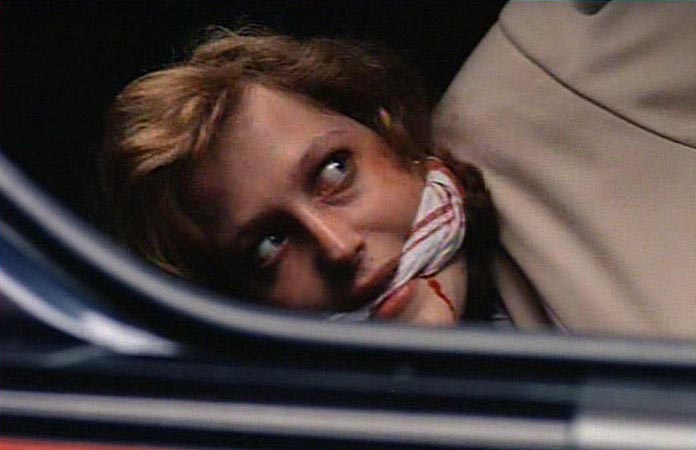 Scully’s abduction in Season 2
Scully’s abduction in Season 2
Thus it was that, following the closure of the X-Files at the end of season one, with the pair separated and Mulder gallivanting around with Alex Krycek (later affectionately dubbed “Ratboy” by fans, who were also now calling themselves “X-Philes”) that Scully spent most the early part of season two on the phone, staring at a computer screen, carefully framed in medium close-up. Looking at those episodes with the benefit of hindsight is amusing in a way, the showrunners going to any and all lengths to keep Scully away from the action. The masterstroke proved to be launching Scully full-force into the action in a way that Mulder wouldn’t get to be for several years: she was abducted.
For this writer, the “Duane Barry”/”Ascension”/”One Breath” trilogy (again. . . let’s pretend “Three” doesn’t exist) was not only the highlight of the early seasons of the show, but also the gateway into the idea of a show having a consistent and ongoing mythology, one that would influence your Buffy, your Lost, even subsequent procedurals like CSI. It’s brave to ask a viewer to tune in every week, in case there is a hint that the main story ever inches forward, and the “Abduction” arc (as it was known on the UK VHS compilation) was a brave move for the show. More importantly, it reminded us (along with season opener “Little Green Men”) that this was a show about aliens. Within those two and a half hours, we were treated to an FBI standoff, Scully’s disappearance, an audacious stunt on a moving “Skyland Mountain” cable car (one which Duchovny performed himself), and a meditation on the afterlife, not forgetting Mulder’s first real run in with the Cigarette Smoking Man and Krycek’s deception. There’s enough in those episodes to pad out a whole season, but The X-Files was about to begin its delve into serious mythology, perhaps, for some, going too far.
The remainder of season two is peppered with gruesome, nasty episodes (“F. Emasculata,” “Irresistible,” “Our Town”); a few clunkers (“Dod Kalm”, the execrable “Fearful Symmetry”); the return of Mulder’s sister, albeit as a clone; and the arrival of Brian Thomson as a Schwarzenegger-as-Terminator channeling Alien Bounty Hunter, determined to keep the planned colonization of Earth on track. In fact, the show was audacious enough to throw in the “Colony” two-parter shortly after “Abduction” and only briefly before the finale, “Anasazi,” would expand upon the Mulder family involvement with conspiracies and aliens.
It’s probably possible to pinpoint the moment that the show went from cult following to mainstream success, and it’s the end of season two and start of season three. It’s also where the beginning of the show’s long battle with popularity and appeasing fans began, something that the show never truly resolved. While the show began to become more and more of a phenomena—it was this season where Duchovny and Anderson curled up on the famous Rolling Stone cover—at the same time, Carter, Spotnitz, and even Duchovny (now gaining “story” credits) were expanding and pushing the mythos of the show into deeper and darker rabbit holes.
Opening season two-parter “The Blessing Way” and “Paper Clip” began to pursue the colonization storyline even harder, bringing Mulder’s sister back into the equation in a rather Sophie’s Choice way, mixing in Scully’s abduction, Mulder’s father’s death, Nazi war scientists, and introducing the shady cabal known only as “The Syndicate.” Perhaps setting the bar a little too high for new arrivals to the show, the season began to splinter off into two separate formats. The “monster of the week” episodes became more and more surreal, much to the delight of critics and fans alike, and the show became more playful with its established formula. We were given “Clyde Bruckman’s Final Repose,” “Jose Chung’s ‘From Outer Space’,” and “War of the Coprophages,” black comedies that poked fun at the now established personas of Mulder and Scully, with “Bruckman” foretelling Mulder’s death through “auto-asphyxiation”—a reference to an element of the character that only keenly observant fans would spot: his obsession with pornography. Perhaps more intriguingly, Scully was told that she wouldn’t die, the beginning of a fan theory that the showrunners played with over the next few seasons.
Sadly, this meant the more formulaic episodes became slightly hokier and more obviously inferior. For every “Pusher”, there was a “Teso Dos Bichos;” for every “DPO,” a “Hell Money.” Whilst the show was gaining plaudits and awards for its strong episodes, it would be one more season before the entire run could be considered consistently strong. On the other hand, away from the casual viewers, the season three mythos is, for this writer’s money, the best it ever was, particularly early on.
In “Nisei” and “731” we returned to smallpox and the government’s use of this to develop a vaccine to fight the threat of colonization. However, more excitingly, this was wrapped up in a ludicrously enjoyable action thriller yarn set aboard a Canadian train, with Stephen McHattie’s sharply dressed NSA agent an incredible foil for Mulder. If you’re new to the show, or are trying to convert someone to the FBI’s finest, there are few better places to start than the “82517” double bill.
“Piper Maru” and “Apocrypha” are also worth a notable mention, not only for the return of Krycek, or the (in retrospect) hilarious way in which the behind the scenes crew suggested that Mulder was in “Hong Kong” (one corridor with a neon sign and an Asian restaurant do not a city make), but for the introduction of the Black Oil, the alien virus introduced by those intent on enslaving the human population to ease the process of colonization. With some nifty CGI showing the oil cross over characters’ eyes, it was a fun way to have a character “turn” for a short period, without destroying their established role in the show. It would also serve its purpose in a couple of years, when the show would hit both the big screen and the computer screen.
It’s a shame, therefore that the season finale, aside from cheaply bringing back Bill Mulder and Deep Throat via way of the now established shape-shifting alien, is such a dud, fizzling out as Jesus-alike Jeremiah Smith flatly states “he’s here to kill me” while Thomson’s Bounty Hunter approaches. It was the last time the show would have a cliffhanger so poor, however. Change was coming.
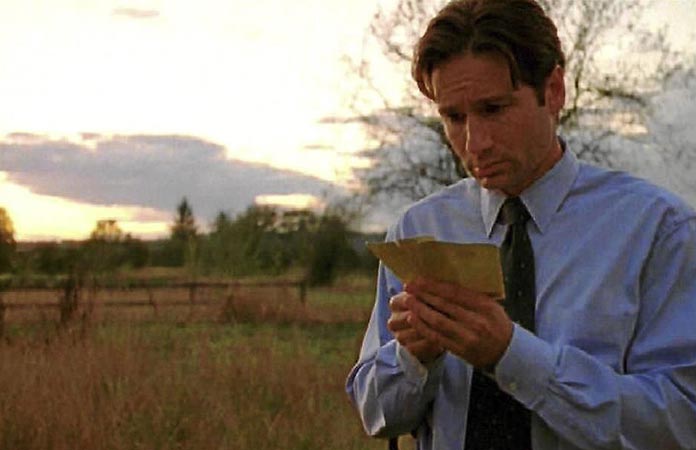 Mulder in “The Field Where I Died,” Season 4
Mulder in “The Field Where I Died,” Season 4
It’s jarring to look at season four onwards in comparison with the first three seasons. Clearly, Fox knew they were onto a winner, and the production values of the show increased in kind. Season four has a slightly glossy look, as if the Black Oil is smeared over everything, and while the show wasn’t quite ready for the shift from gloomy Vancouver to sunny Los Angeles (that would come after the film), there is a definite improvement in the show’s visual aesthetic.
The expanded budget clearly gave the writers more freedom to work with, and early season four piece “Home” demonstrated the grotesque skills the visual effects team were capable of. It’s worth noting that “Home,” one of only two episodes to gain a “content warning” and often rumored to have been banned by Fox, was not actually banned per se, but not aired on broadcast TV. It would next be seen on the FX network. The episode signaled the return of Glen Morgan and James Wong, writers who had left the show in season two, and would later leave again to co-create the Final Destination series. Watching “Home” again is incredibly jarring, not just for the gross-out factor (although that did hit a series high) but also tonally; it’s the product of two jokers, trying to see how far they can push the show, into the realms of the extreme. A fascinating curio, but not up to the standards the rest of the season was going to hit.
Season four was all about emotions. Who was the Cigarette Smoking Man? What drove him? What are our memories? What is our soul? Season four gets dark, way darker than anything previously hinted at. Whilst the mythology is notably weaker—the return of “Fallen Angel’s” Max Fenig barely even registers—it’s the individual episodes where the show makes its mark. Clearly the makers understood this, and it’s during a routine MOTW episode where Scully first discovers she has Cancer. Mulder, however, is on a journey of his own, into his memories, into accepting that his sister may simply be dead. The double whammy of “The Field Where I Died” and “Paper Hearts,” two episodes disguised as routine investigations, are an incredible pair, slow and melancholy. The show finally understood that there was more to it than just the hint of seeing a UFO, or the search for extraterrestrials. It was always about the journeys of Fox Mulder and Dana Scully, and having their faith questioned and challenged. Having seen Scully take the brunt of this in the first few seasons, Mulder’s realizations in “Paper Hearts” remind us that he is not just an encyclopedia of phenomena. He is a human character, a lost boy simply looking for his sister.
The season ended with perhaps the most shocking moment in the show: Scully, tearing up, in front of a committee, explaining that Mulder had killed himself. “Gethsemane” needs to be seen in context—there were rumblings at the time that Duchovny was unhappy with his contract, that the show was going to end after season five. With this in mind, it was a genuine “holy crap” moment, with fans left on the edge of their seats for a long summer. Of course, in hindsight, the juggernaut wasn’t going to be stopped by an apparent suicide. There was a film to prepare for.
Season five showed us, fairly quickly, that Mulder wasn’t dead. Of course not. But Scully nearly was. Season five was a season about endings. Scully’s cancer was eating away at her and Mulder briefly ended his belief in UFOs thanks to Michael Kritschgau. The only things that hadn’t ended were the contracts. But preparations had been put in place to ensure that should Duchovny decide to jump ship, then new blood needed to be brought in to the show (which would, ultimately be the case later on). Thus we met Agent Jeffrey Spender, a character who didn’t quite endear, or stay within the memory. It would take some horrific incidents for that to happen.
Season five was bumpy, juddery to say the least. But the popularity continued. The show was the most popular in Fox’s schedule from 1997-1998. Showrunners were prepping for the film, so clear narrative moments were put in place. We had the black oil pushed further into the fore, the Syndicate giving up their own in order to pursue their own ends further. In essence, the show became muddled, confused, and the mythology near-impenetrable. The film seemed less and less likely to welcome new fans with open arms.
But if the mythos was tripping over itself, the stand-alone episodes still impressed. The writers were confident enough to give The Lone Gunmen their own episode, with “The Unusual Suspects” exploring their origins. Through the unexpected highlight of seeing a different side of Mulder, seemingly a villainous G-Man, the show also introduced the character of Susanne Modeski (who the Gunmen would cross paths with again), perhaps conveying how he would look to the rest of the world, had we not known him so well. The bonus of this episode, of course, was that the minimal involvement of Duchovny (and no Anderson) allowed the film’s shoot to continue uninterrupted.
There was “The Post-Modern Prometheus,” long regarded as one of the finest stand-alone episodes, Chris Carter’s homage to Frankenstein, shot in black and white, and with the use of Cher as a major plot point. It’s bonkers, silly, and somewhat sad, perhaps representing the show. There was the return of Robert “Pusher” Modell in “Kitsunegari.” As with Flukeman and Tooms, the show brought back a favorite villain of viewers. The episode isn’t quite up to the high standards of season three’s tense thriller. “The Pine Bluff Variant” saw Mulder working undercover, gnarly chemical-warfare effects, and the relationship between our agents straining. And then there was “Bad Blood.”
Part “Rashomon,” part comic-spoof, “Bad Blood” remains the funniest episode of the show, and, in playing to the strengths of the lore, benefits from knowledge and devotion to the lead characters’ personalities. Mulder and Scully both tell their own versions of a (fairly trope) vampire case, in each, playing up the personalities of their respective partners. A knowing poke at the established templates of the show, and at the developed characters, it’s no surprise that this episode remains a fan favorite and boasts the honor of being Gillian Anderson’s favorite episode.
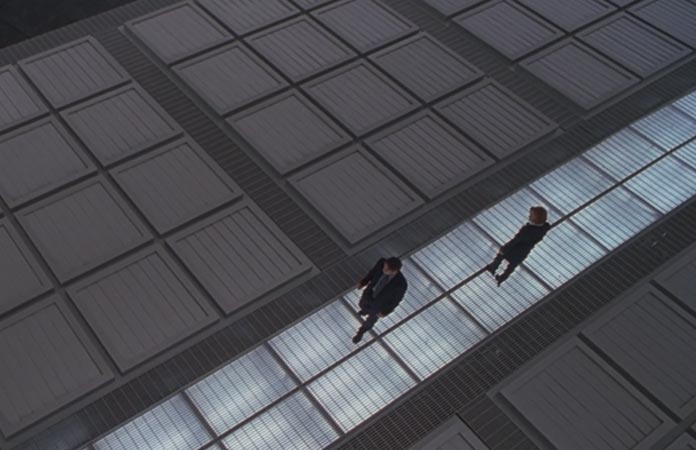 Look at the budget! The movie.
Look at the budget! The movie.
The good times couldn’t last, however. At the end of season five, it was announced that the show would be filming in Los Angeles, away from dark and dreary Vancouver. Despair that the show would lose its moody aesthetic was tempered by the announcement that Duchovny WOULD be returning for two more seasons. However, the burning down of the iconic basement office in season finale “The End” left fans wondering what would happen to their beloved show. Would there be a reboot? New agents? With all this fear, it was time to Fight the Future.
In summer 1998, The X-Files Movie was everywhere: posters plastered on walls, trading card sets, tie-in soundtrack (featuring “Walking After You” by fans of show, Foo Fighters— Dave Grohl has a blink and you’ll miss it cameo in “Pusher,” too), and atmospheric trailers in cinemas. The film was released in June in the US as PG-13, and as 15 in the UK in August (this writer turned 14 in August 1998, and remembers all too well coming up with an elaborate ruse to sneak in).
And after all that hype? Middling. The film was received modestly by both critics and audiences, although it did rake in nearly $190 million worldwide from a $60 million budget (helped considerably by the show’s popularity in non-US territories, notably Germany, the UK, and Japan). Despite Carter’s claims that he wanted to create a film that would entertain non-fans, the film is as dense as the mythos of the show. Events such as the death of the Well-Manicured Man drew a shrug from casual viewers, and the black oil was poorly explained (having been better served back in the “82517” two-parter). It’s a bit of a mess, helped by some spectacular sequences. The opening bomb detonation is a doozy, and some of the set design, particularly in the latter half of the film, is great. But it was a sign of things to come with the franchise on film and for the show. This was peak-Files, and while the show remained popular, it was all downhill from here.
Season six found itself picking up the pieces of the film, while also stretching the show in terms of range. There was a continuation of experiments such as “Prometheus” and “Bad Blood.” In the mythos, as fans had expected, new agents were being roped in. We were introduced to Diana Fowley and Jeffrey Spender, the latter never quite finding his ground as either tragic character or villain. His mother, Cassandra Spender, managed to find more footing as the former, and would play a large part in filling in several of the blank spaces the mythology had now created. The saga of the Syndicate rolled on, although, thankfully, came to an abrupt end, in the “Two Fathers”/”One Son” two-parter, which also introduced to us even more aliens (ironic that a show about the elusiveness of alien life would become overburdened with so many races) in the form of rebels who had mutilated their faces, sewing up their orifices to prevent exposure to the black oil (also still rolling on).
Frank Spotnitz, the co-writer of the show, was unhappy with the eventual reveal of these aliens, claiming that they didn’t quite get the effects right in order to scare the viewers. The rebels did their job, however, trying to prevent colonization by burning the Syndicate alive. With that, it was time to find more stories to tell, and the show, perhaps preparing the shark tank and the motorcycle, finished the season by connecting alien life to religion, the Mayans, and natural disasters, in “Biogenesis.” Thus, the stage was set for the final, bonkers layers of the mythology.
Despite this, the stand-alone episodes continued to throw in surprises. “Drive,” early in the season, was not only a nasty, violent thriller, it’s also likely the genesis of another cult show, Breaking Bad, being written by its creator Vince Gilligan (returning to the show after a hiatus) and starring special guest Brian Cranston, beginning to move beyond his Malcolm in the Middle persona. While the change in the look of the show to glossy and sunny (as a result of the L.A. move) is very apparent in this episode, it remains a taught, visceral piece, with more shocks than one would expect by this point. “Triangle” is another delight, a (somewhat failed) experiment at doing sections of episodes in single takes, but a fun and funny time-travel piece featuring Anderson in top form as a period character, perhaps pointing at the direction she would take post-Files. “Monday” is Groundhog Day through the Files filter, and “Arcadia” puts Mulder and Scully undercover as a married couple. It’s fun, silly stuff, and probably the last overall consistent seasons of the show. By season seven, Duchovny was getting antsy, ready to move on, and the show creators sensed this. It was time to create an “ending.”
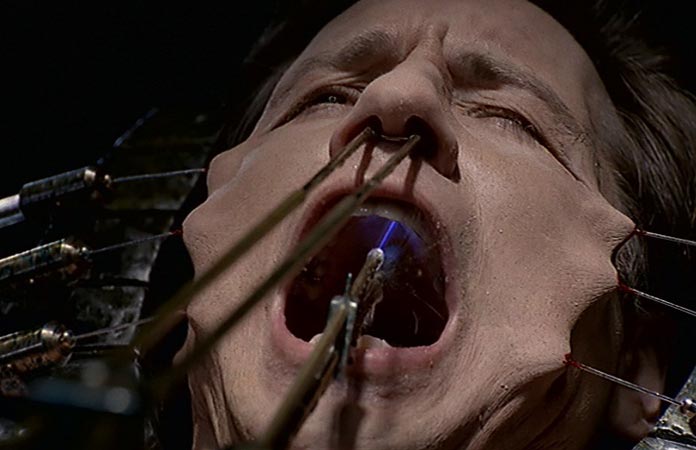
Mulder being abducted and tested on. Yes, this happened.
Season seven was the last one to star Duchovny full time; he would return intermittently in the latter (some would say “optional”) seasons of the show. At the time, it was positioned as an “ending” to the show, and as such, wraps up so many hanging strands of the mythos, most notably, Mulder’s search for his sister. In addition, Carter’s other show, Millennium, was abruptly cancelled, and therefore the episode, also named “Millennium,” was written as a cross-over to wrap-up Frank Black’s own narrative (although fans are at pains to note that in a previous episode of Millennium, The X-Files appears as a TV show).
In “The Sixth Extinction” two-parter, Mulder, seemingly mad due to his overworked brain activity in reaction to an alien artifact, is now in lockdown. Skinner and Michael Kritschgau, who would be one of several returning characters this season, seek to find out what is happening to him. It all goes into the realms of the insane, with mind-reading abilities (surely this would basically solve every case from here on?) and dream sequences of colonization akin to a disaster movie.
In “Sein Und Zeit,” Rebecca Mulder finally passes away, apparently taking her own life. Afterwards, in the second part, “Closure,” Samantha Mulder is also revealed to be deceased, wrapping up what is essentially the driving force behind the show. Indeed, the series never quite found a real motivation after this, despite the wonderful lure of the colonization date approaching. Finally, in “Requiem” the show returned to the “Pilot” and to the story of Billy Miles. The Cigarette Smoking Man was apparently dying (not the first time. . . or the last) and Mulder finally got what he had been looking for: contact. The season ended with Mulder’s abduction, which Skinner also witnessed, turning him into a believer. The Cigarette Smoking Man was thrown down a flight of stairs—not enough to take him down yet—and Scully was. . . wait for it. . . pregnant. A messy ending, but an ending, nonetheless. Carter believed the show could continue (he talked of another ten years), so the threat of season eight sat heavily in the background.
Stand-alone episodes in season seven become much harder to recommend, perhaps due to the over-reliance of gimmicks in the show: “Hungry” was a story from the monster’s perspective; “Rush” was a special effects showcase; “Orison” committed the fatal sin of revisiting Donnie Pfaster, the terrifying necrophiliac from “Irresistible” and making him a demon. It was quite a move, ruining the power of one of the most potent early episodes. There are a few that do stand out, however. Most notable: “X-Cops,” a cross-over with Fox show Cops, was filmed in that show’s documentary style and was both smart and funny. There was “All Things,” a Scully-centered episode written and directed by Anderson that imagined “what if” she had never met Mulder. Duchovny’s own turn at writing and directing was “Hollywood A.D.,” a somewhat ouroboros-like tale of film producers wanting to create an X-Files movie (perhaps hindsight had kicked in for those involved in Fight the Future). But overall, it’s a clear sign that this is a season where you can start flicking through the episodes, picking out ones that appeal, rather than feeling compelled to watch them all. And that feeling would continue, as the show kicked on.
Season eight. Oh, season eight. Immediately notable, the show’s opening credits changed. This writer could never quite get into them, the original sequence implanted in memory. Mulder was replaced by John Doggett, gamely played by Robert Patrick, a hard-nosed FBI agent organizing a taskforce to find Mulder. Doggett is eventually assigned to the X-Files, and partnered up with Monica Reyes, a violent crimes specialist. Wait. . .
Yep, season eight was the reboot. Duchovny appeared in half the episodes, Anderson in most, but it was a clear attempt to keep the show going after their imminent departure. Most of Duchovny’s appearances are shirtless, in fleeting glimpses of his torture (perhaps preparation for Californication?). Scully, on the other hand, becomes more worried about the future of her own child. Off-camera, Anderson wasn’t happy with the lack of focus on Scully’s character, as the next generation of the FBI was being thrust to the fore. According to rumors, Duchovny offered to write and direct an episode about Mulder’s imprisonment on the alien craft; this was rebuffed by Carter as it was not “about Doggett.”
There’s not a lot to recommend from here on out, but some notable moments include: “MULDER’S DEAD!” in “This is Not Happening” followed by “NO HE’S NOT” in “Deadalive.” (Doggett would perform the same trick in “The Gift.”) “Three Words” is worth a look in continuing the colonization story, and, if looking to stave off the boredom, “Essence” and “Existence” help set up season nine. Yes, season nine. The season ended with the ultimate fan service: Mulder, the father of Scully’s new born baby, William (yep) kissing her. It’s all over, guys.
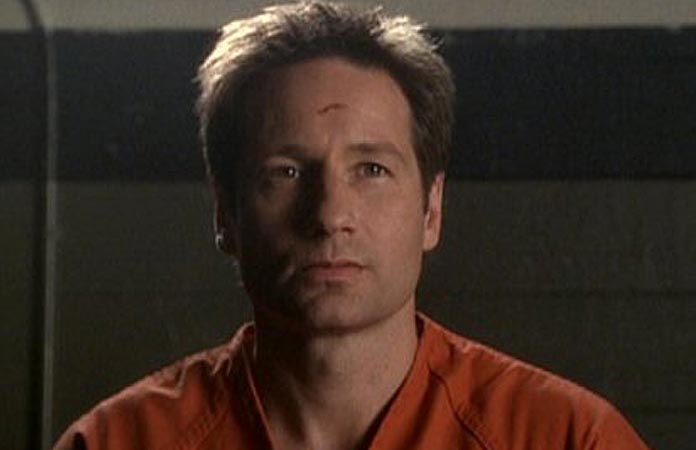
Mulder on trial in the final episode.
Season nine was the final one for a show that had reached its real conclusion two years before. Let us take a minute to ponder the following word: supersoldiers. Yes, the main focus of this final year was around the concept of “supersoldiers”—human hybrids created as a last-ditch option for colonization. The idea was that these regenerating (and overused) figures would serve as a replacement for the enslaved human race. Made of metal, they can essentially survive anything (the casting of Patrick as Doggett apparently made pilfering from Terminator 2 fair game). The first supersoldier? Why Billy Miles, of course. The show had done it. It had finally hit the point of ludicrousness that stretched the suspension of disbelief to breaking point. And this is a show about ALIENS.
Carter had continued to think about the show’s existence, creating spin-off The Lone Gunmen, which unsurprisingly floundered, and as such had to give closure to their characters. Thus it was that the aptly named “Jump the Shark” served, much as “Millennium” had, to wrap up their stories. The Gunmen meet their deaths at the end of the episode, tragically and heroically sacrificing themselves, slightly off from their initial characterization. But to hell with that, the show was going down in flames magnificently.
Once more, there’s little to recommend, a splurge of new mythos characters (Cary Elwes, anyone?) doing little to endear themselves to anyone. Duchovny only appeared in two episodes this season, most notably causing all sorts of havoc in the two-hour season finale, really the only thing worth watching.
Yes, “The Truth.” In the first hour, a court case reviews the entire history of the show, explaining in really clear detail the entire mythology, each race of alien, and what the hell has been going on. It’s a sad state of affairs that this was actually needed in the first place, although somewhat unsurprising. In the second, the show really does go out with a bang. Mulder, returned, breaks free from prison, finally kills Krycek, makes it to New Mexico and we see the FINAL death (right?) of The Cigarette Smoking Man, his skull gloriously set aflame by attack helicopters. Oddly enough, the show does actually resolve itself somewhat redemptively. In the final shot, Mulder and Scully lie in a hotel room uncertain as to what will follow, as the date of colonization is still set for 2012.
Fade out.
And this brings us back to where we began, I Want to Believe. The 2008 film was the last time we saw Mulder and Scully on the big screen, and while IDW is gamely picking up the slack with the “Season Ten” comic (spoilers: The Lone Gunmen aren’t actually dead and everyone’s favorite Cancer Man probably isn’t, either), the last time we really saw Mulder and Scully, they were sitting on a row boat waving to camera. Much like Scully’s assertions throughout the show, something like that needs to be seen to be believed.
I really do want to believe, Carter et al, I really do. I want to see Mulder and Scully have a sending off fitting for some of the best television writing ever. As I look back over the last few years of the show, and the second film, it seems like the show was always on a rickety course, just staying stable, keeping us along for the ride, whilst always seeming likely to fall off the tracks. I hope there’s something more for us, but with the reveal that the new X-Files Board Game sticks rigidly to seasons 1-3, perhaps it’s better to just remember the good times.
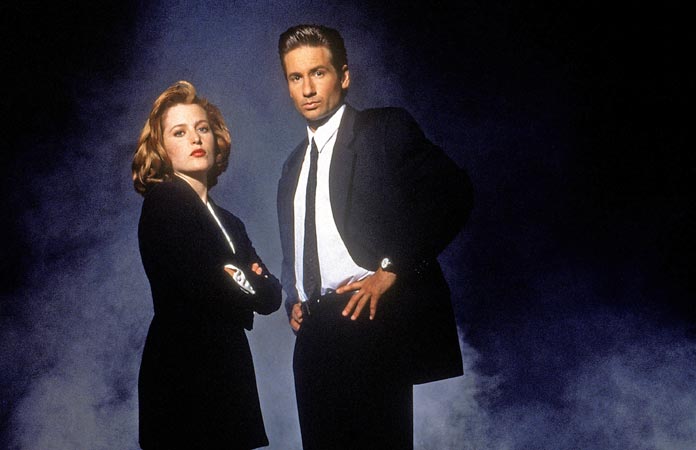
Time limit is exhausted. Please reload the CAPTCHA.